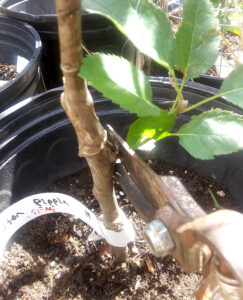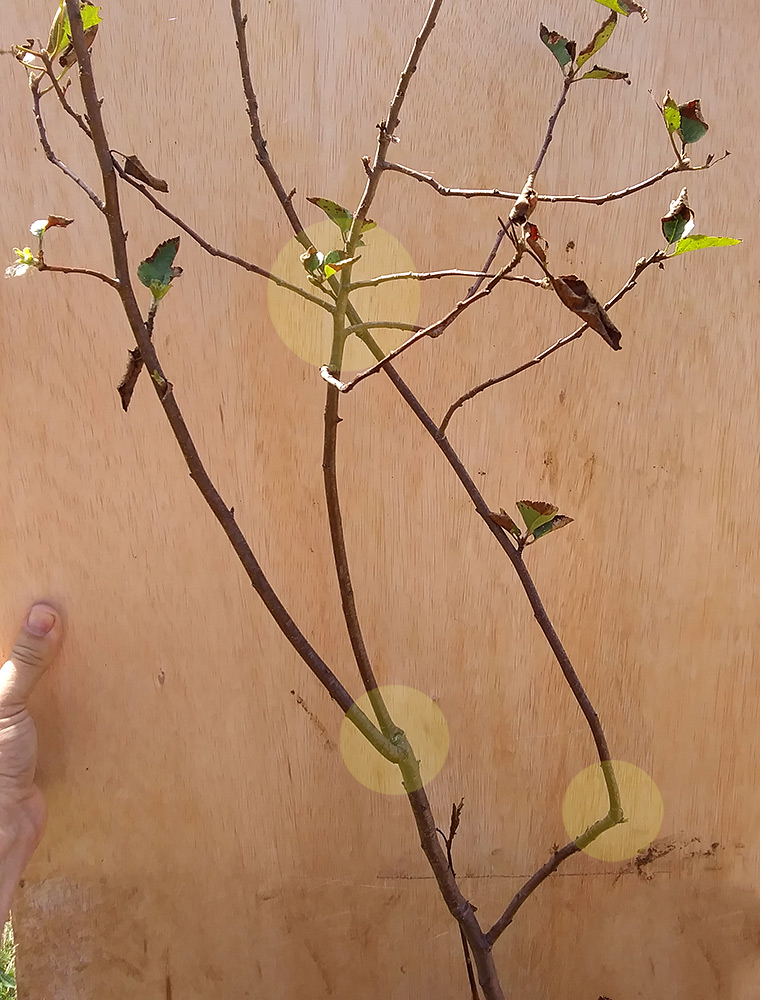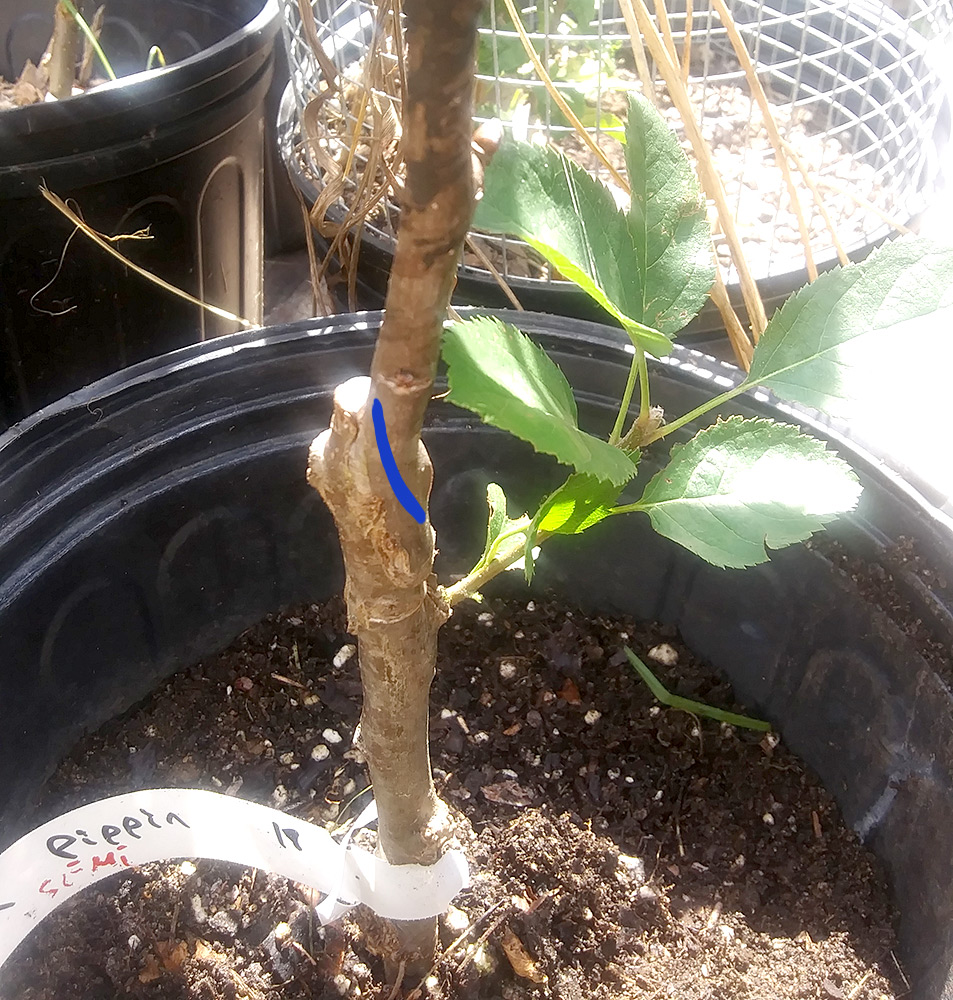This article will showcase some pruning tips, especially for the early years of your tree.
Many new apple tree owners stress about pruning their trees…
There are two goals when pruning;
- the first is to define the shape.
- the second is to promote healthy growth.
Contrary to what you’ve been told, pruning for shape is not as critical as you might think.
Pruning to shape is where the commercial orchard mindset starts to creep in. For those guys, the overwhelming goal is to get every ounce of fruit humanly possible.
For the backyard orchard, early tree pruning to form the shape of the tree… is more an aesthetic choice than anything else.
And while commercial orchards have given us a handful of standard shapes. Apple trees gonna apple tree all on their own, despite what shape YOU want them to grow in.
Not every apple grower needs to be Mr. Miyagi, intricately pruning every bit and piece on an apple tree, to get some wonderful work of art.
I mean you can.
There’s nothing wrong with that. You may find it very relaxing and life-fulfilling to really shape your trees.
And if you know a specific shape or form you want, you CAN start developing it right away…
But that level of dedication and the rush to begin shaping your tree immediately, simply isn’t required.
Young apple trees give you a lot of flexibility. And there’s a train of thought that NOT REALLY TOUCHING THEM right after planting does more help than harm… Either way, the truth of the matter is, as a backyard orchard grower, once you establish a bunch of trees in the ground, you’re likely to start looking for ways to REDUCE your pruning duties. But I digress…
The more important aspect of pruning, comes when trying to promote healthy growth of the tree and nip any problems in the bud, if you’ll excuse the pun.
Luckily, you only need to look out for, and execute a few basic pruning cuts to really keep your trees happy and healthy.
We’ll cover all this on this page… as soon as I get a hot minute to finish (I did already take a bunch of pictures!)
Heading Back to 30″
One of the biggest pruning pieces of advice from the box store is cut your newly planted whip tree, down to 30″.
Sure… if you want to.
But why do you want to?
Are you planning to do a tree form that requires it?
A healthy 48″ tree, will grow just as nicely in the spring as one you cut down to 30″ when you plant it. So why lose the height?
If you’re planning on doing a Central Leader form, I don’t recommend heading your tree back when first planting.
If your tree is growing TOO FAST and experiencing problems holding up its own weight, sure, you might want to cut it back a bit… but to think all bigger trees can’t support themselves and NEED TO BE CUT BACK, is just crazy talk. Strong trees grow bigger roots and thicker trunks faster.
If they’re thriving. Let them thrive, I say!
Of course, there’s nothing wrong with cutting a tree down to 30″ if you want to redirect new growth and do an open center, or modified leader shape. But again, this is mainly aesthetics… so don’t stress about it.
Young apple trees are very forgiving. Any pruning wounds less than 1.5″ – 2″ heal up quite fast. It’s larger diameter cuts that take more time to heal and become a bigger consideration as a vector for disease.
Basic Pruning Cuts
To the left I have a rootstock that has been growing unattended for a year or so… It highlights a couple of the basic pruning considerations for young trees.
Crossing Leaders/Branches
In the middle you see one of the branches has swooped back and is litterally rubbing up against the central leader.
You never want this. It’s crowding the center of the tree and any time two branches rub on each other, you’re in for trouble.
If you look to the lower right highlight, we could prune the backwards growing branch at this point, to allow the the remaining portion to grow out again, this time, hopefully straight out away from the tree!
Crotch Angles
When branches grow away from a leader or main scaffold, they create angles.
Anything between 45-90 degrees will work, but right at 45 and right at 90 are not quite ideal.
The best crotch angle is about 60 degrees, with 50-80 degrees being optimal.
When you spot this backward growing branch, we could just remove the whole thing at the trunk. But if we follow the branch back to the trunk from the lower right highlight, we see that the branch actually has a near perfect crotch angle. That’s why in this instance, we almost certainly want to prune at the highlight point and see if the branch grows out and corrects itself.
If we look to the lower highlight at the left, we see another branch coming off the main leader going off to the left.
Notice here, the angle between the two branches is REALLY TIGHT. Probably like 20 degrees or something.
Tight crotch angles are NO GOOD, because the lock wood together in the crotch. In other words, as the tree grows, it begins to grow against itself and creates a structural weak point prone to splitting!
Aesthetic Choices
In this example, we’re talking about cutting that backward growing branch to free up the central leader.
Well, ME PERSONALLY, I kind of like it when my trees do funky tree things. So if this was an actual tree in the orchard, I might leave the backward growing branch and cut the central leader! Once the central leader of this tree is gone, the backward branch wouldn’t be rubbing against anybody… and would grow without further issue.
If you’re choosing a certain form for your trees, then off course, the form will dictate where you make your cuts.
Opposing Branches
If we look back to the highlight area where the two branches split off from each other. This illustrates another basic, important aspect. Even if the crotch angles are good, when two or more branches grow off at direct opposite sides of the tree, this creates another weak point prone to splitting.
This is explained as the main problem with open-leader formed trees, on the tree form article. Lot’s of folks try and let branches spring off in different directions from the same point on the tree, and lots of folks deal with trees splitting in their orchard!
Dead Branches
Sometimes branches die off from bug damage, disease, weather, or whatever. If you see brittle, dried out looking branches, prune them out. They ain’t doin’ anything helpful for the tree.
Suckers
Suckers are new shoots from the rootstock.
They rob energy from the tree you’re actually trying to grow and show be removed as soon as you spot them.
To the right I have an example of a sucker that is super close to the actual grafted tree. I put a blue line so you can notice the graft wound directly underneath it.
The sucker, shooting off to the right is just at the right top most part of the original rootstock.
It’s gotta go!
A lot of times, suckers grow up from the trunk of the tree, right where it meets the soil. Other times, suckers come up right through the dirt surrounding the tree.
In the old days, when most trees were seedling planting… Trees would actually be propogated through these suckers.
But these days, with most trees being grafted trees, suckers that come up BELOW the graft, will only produce more rootstock trees, not the variety you’re trying to grow.
Remember rootstock is chosen for a whole bunch of qualities, except fruit! So growing out a rootstock to fruit, doesn’t usually, deliver great results.

Water Sprouts
Water sprouts are thin shoots very much like suckers, but that arise on the branches of an apple tree.
They grow near vertical seeking to assert themselves as vegetative branches, not fruiting wood.
Remember, apples grow on horizontal branches, vertical branches don’t release the hormones to fruit.
Water sprouts divert energy from everywhere you actually want it. They thicken a tree’s interior blocking light and airflow and basically should be pruned as soon as you spot them.
Competing Leaders
If you’re working on a central-leader form… you don’t want other main leaders, growing mostly vertical competing with the main leader. If you allow this, you get a codominant tree and this changes the nature of the way the tree grows; slowing down resource distribution and creating a wider spreading tree rather than a vertically growing tree.
If your competing leaders come from good points on the trunk, it’s not unhealthy for the tree. A tree CAN thrive under codominant competing leaders, BUT it will not take the form, or take advantage of the central-leader form you were going for.
Extra Scaffolds
Apples trees should fruit on tiers, or specific, strong scaffolds. As mentioned elsewhere you want these scaffolds to generally be 8″-12″ or as up to 24″ apart, spread around the tree to distribute the weight evenly.
As the tree grows it will continually produce new branches between your primary scaffold branches. You want to remove these to focus all the trees energy into the primary scaffold branches you’ve chosen for the tree.
Downward Branches
Apples trees give the greatest fruiting hormone signals to branches that are ideal for fruit, branches in that sweet spot crotch angle we spoke about earlier. Branches that grow too vertically don’t get the signal… and this applies to vertical growing the other way, downward!
Also, branches that are just going slightly downward, not so much vertically, while they may get the signal to make apples, these branches aren’t able to support much weight. Since they’re already hanging, developed fruit often makes them fall against lower branches (or the ground, if it’s a low branch to begin with).
This never ends well, so it’s best to prune out any downward shooting branches.
More to come.

